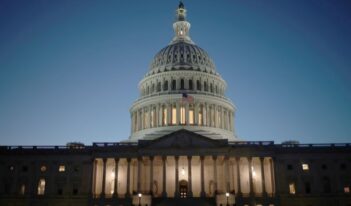
States can continue to support access to health care, but their efforts depend on federal support.
Recently, the U.S. Congress took a major step toward passing legislation that would undermine access to premium tax credits that subsidize health insurance made available by the Patient Protection and Affordable Care Act (ACA).
This development, along with broader efforts by the second Trump Administration to reduce federal funding for health benefit programs, would require states to fill increasingly larger gaps if they want to protect access to and the affordability of coverage.
Just weeks into the Trump Administration, the Office of Management and Budget issued a temporary freeze on “all activities related to obligation or disbursement of all Federal financial assistance.” Within 24 hours, state Medicaid programs reportedly faced interruptions, and the Trump Administration rescinded the order the following day. Since then, Trump II has stripped funding from and reduced the workforce of federal agencies that administer health care programs, and proposed a rule that would dramatically restrict access pathways for ACA marketplace health insurance.
Still, it is difficult to make sense of the whirlwind of President Donald J. Trump’s first 100 days in office, especially when assessing how the new Administration’s efforts will impact access to health care. Looking back, though, experts are not without resources to understand President Trump’s health care playbook. A useful starting point is Project 2025’s Mandate for Leadership, a Heritage Foundation-sponsored initiative that gained prominence as President Trump launched his reelection campaign.
Using Project 2025’s Mandate as a guide may be instructive, especially since Trump II’s health care agenda is unlikely to be as transparent as Trump I’s, which, from the outset, set a clear goal to repeal the ACA. The authors of Project 2025 even claim that Trump I “relied heavily on” the former edition of their Mandate, reporting that the President embraced “nearly two-thirds of Heritage’s proposals within just one year in office.”
Will President Trump try once more to repeal the ACA in its entirety? Project 2025’s Mandate does not call explicitly for repealing the ACA, but it critiques the U.S. health care system for being “broken,” blaming the ACA for the “dramatic increase in Medicaid expenditures.”
Throughout his 2024 presidential election campaign, moreover, President Trump did not endorse a full repeal of the ACA. But in a December 2024 interview, the then-President-Elect stated that he “would love to” replace the ACA with “something better,” making it more difficult to predict the ACA’s fate under Trump II.
Project 2025’s Mandate identifies several targeted areas for reform to advance Trump II’s clear objective of reducing federal and state spending. To encourage “states to save money,” the Mandate proposes that the federal share of Medicaid funding be capped using block grants—fixed pools of funding allocated by the federal government to states. Alternatively, the Mandate proposes that policymakers introduce other forms of caps on federal funding to state health care programs, for instance, by limiting federal funds using a preset formula, under which funding would not vary based on the actual cost of care.
The Mandate also calls for the repeal of “harmful health policies enacted under the Obama and Biden Administrations,” such as the Inflation Reduction Act, which expanded premium tax credits for low-income individuals buying marketplace health insurance. Repealing legislation such as the Inflation Reduction Act would hurt states that have supplemented federal subsidies to make insurance more affordable for their residents.
These proposals are designed to undermine the most controversial aspects of the ACA: the Act’s “Medicaid Expansion” provisions and efforts to increase access to subsidized coverage through the ACA’s health insurance marketplaces.
Through the ACA’s Medicaid expansion provisions, which have been adopted by 40 states and the District of Columbia, over 24 million people gained access to health insurance coverage. Under the ACA, states can also run their own “marketplaces”—online websites where individuals can buy private health insurance plans that meet the ACA’s consumer protection requirements. Furthermore, as of December 2024, over 19 million people were enrolled in marketplace health insurance that was heavily subsidized by federal funding. Critics argue that these features contribute to fraud, waste, and abuse.
Since it was passed, policymakers have supplemented the ACA, enabling states to build upon federal-level protections by innovating to increase the affordability and quality of health insurance. But states depend on the ACA’s framework to pursue innovative policies, and efforts to undercut the ACA’s protections will limit the flexibility states have to experiment.
California, for example, created a “cost-sharing reduction program,” which, starting in 2025, will eliminate deductibles and reduce out-of-pocket costs for residents with incomes above 200 percent of the federal poverty level. California is building on the ACA and other federal policies that have made health insurance more affordable by loosening the eligibility requirements to access federally subsidized insurance.
To build on federal assistance programs, many states have created transition programs to fill health insurance coverage gaps and help individuals who are no longer eligible for Medicaid to transition into affordable marketplace coverage. For example, Maryland automatically enrolls those who lose their Medicaid coverage in a marketplace plan that imposes the lowest monthly premium and cost-sharing obligations on the consumer.
Other states have responded to the problem of coverage gaps for specific populations, such as undocumented individuals, who often cannot access health insurance that is subsidized by the federal government based on income level. Colorado’s marketplace launched a program called OmniSalud in 2021, building on authority from a state law that requires insurance carriers selling plans on the marketplace to make coverage available for immigrants, “no matter their documentation status.” For the 2024 enrollment period, Colorado used state funds to provide financial assistance for up to 11,000 undocumented individuals who received coverage through OmniSalud.
The ACA has faced opposition since its enactment. Efforts to eliminate the protections of the ACA have focused on reducing federal subsidies for individual health insurance while increasing the availability of private coverage options that are subject to fewer regulations. Other efforts focus on urging the current Administration to reduce the “enhanced” Federal Medical Assistance Percentages, which are used to calculate how much the federal government will match the cost of state expenditures. Reducing the federal match rate would decrease Medicaid spending, which the Congressional Budget Office reports would “principally” burden “households toward the bottom of the income distribution.”
If the federal government lowers its Medicaid matching rate, the burden of maintaining Medicaid expansion would fall disproportionately on states, forcing some states to pay more than $1 billion each year to maintain the program.
Some scholars argue that this shift “would make it likely that many states” will opt out of Medicaid expansion and cause millions of people to lose coverage. Twelve expansion states have passed “poison pill laws,” which would “end their expansion, automatically or nearly automatically,” if the federal matching rate drops.
To date, state-level efforts to expand access to affordable coverage have been critical to building upon the ACA’s protections. Project 2025 and Trump II, however, envision a landscape where states take on even more of the burden of administering and funding health care programs.
Without the foundation that the ACA provides, states’ flexibility to support coverage would be constrained significantly. The path chartered by authors of the Mandate and similar proposals would limit the resources states have to support access to health care.
From the outset, Trump II has pursued the policies outlined in Project 2025’s Mandate. Such reforms are eroding protections afforded by the ACA and shifting the responsibility of administering and funding health care delivery to states in unprecedented ways that they may not be positioned to confront alone.



